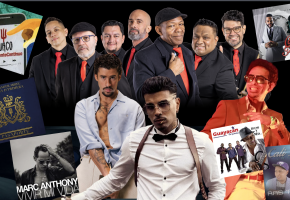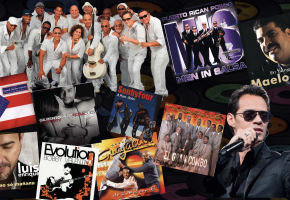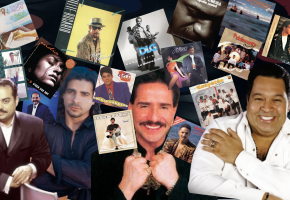TO BE OR NOT TO BE...LATINO
The word ‘Latino’ is a term used mostly in the United States to denote “a person of Mexican, Puerto Rican, Cuban, South or Central American, or other Spanish culture or origin, regardless of race" - according to the United States Census Bureau. Since the first independence movements in the Americas, there have been dreams of a 'united' Central and South America, from Simón Bolívar’s failed Gran Colombia to the more recent efforts of Hugo Chavez to forge a more united region.
Yet, despite the political efforts that have peppered Latin American history, among the general public in Latin America itself there was little notion of a united Latin nation throughout the 19th and most of the 20th centuries. It was a term only relevant to Latin Americans living outside Latin America, ie. immigrants from Central and South America in the US. As the famous social commentator Suarez Orosco said; "The very term Latino has meaning only in reference to the U.S. experience. Outside the United States, we don't speak of Latinos; we speak of Mexicans, Cubans, Puerto Ricans, and so forth. Latinos are made in the USA"
SETTING THE CONTEXT - THE LATINO CULTURAL INVASION
In the United States, Puerto Ricans had been American citizens since 1917, and with them they brought their traditions and their music. In addition, after the Mexican-American War (1846 to 1848) a large number of Mexican nationals, found themselves on the north side of the border. Throughout the first half of the 20th century, Cuba and Mexico had already established themselves as the powerhouses of Latin America’s record industry, especially Cuba, which had been providing the soundtrack for Central and South America since the popularization of the radio and record players.
The most popular genres came from the island; The Son the Guaracha, the Rumba and later the Mambo and the Cha-Cha-Cha. In the early 40 and early 50s, some of the best and most accomplished Cuban musicians moved to the US, including their very best conga players: Chano Pozo, Mongo Santamaria, Armando Peraza, Tata Guines, Francisco Aguabella, Candido Camero and Carlos “Patato” Valdez. Some of them integrated their skills into American Jazz, especially under the tutelage of Dizzie Gillespie.
In 1942 Machito and his Afrocubans released Tanga an instrumental piece considered the first ever Latin Jazz song, a variation of a traditional Mambo (rythim invented a few years before by Orestes and Israel “Cachao” Lopez). It made them hugely popular and opened the doors to a white American audience: the Mambo dance craze in the States became massive. Hollywood fell for Dezzie Arnaz and Perez Prado conquered the American music charts with several number 1 hits.
NEW YORK, NEW YORK
New York was the place to be when it came to Latin music, the large Puerto Rican (and to lesser extent Dominican, Cuban and Mexican) populations were the epicenter of the Latin music business. During the 1950’s a dancehall located in New York called the Palladium became the main venue for music brought by Latin American immigrants and as many as 3 bands would play per night. 1958, with the Cuban Revolution and the closing of he palladium, this started to change rapidly. Cuba was no longer open for business due to the embargo and in the following decades, new Latin musical hybrids formed out of the American experience, such as the Boogaloo.
In the late 60s a new record label was formed by Jerry Masucci, an Italo-American lawyer and Johnny Pacheco, a veteran band leader and flautist from Dominican Republic. It was the birth of Fania Records. In less than 10 years, Masucci’s shrewd business acumen and Pacheco’s old contacts and ear for new talent made Fania the most powerful ever record label in the history of music of Latin origin. Fania’s musicians, mainly from Puerto Rico, Cuban and Dominican origin, made films; and toured around Latin America and the world. Most importantly Fania marketed this Latin music movement under one name: Salsa
THE MARKETING POWERHOUSE OF FANIA
Salsa the became the de facto umbrella name used by the American mainstream media to called all this that sounded Latin ish. By the mid 70’s Fania had a virtual monopoly over Latin music production in NY and was expanding its operations to Puerto Rico, Venezuela and Colombia. Some of the artist in its roster - Ismael Rivera, Celia Cruz, Hector Lavoe, Willie Colon - were as big as anyone could possible be in the Latin Caribbean. Meanwhile, most Puerto Ricans, Mexicans and the rest of the Latinos in NY and the rest of the USA were living in poverty, as poor in the US as they
were in Latin America. And while Salsa always seemed to have a nostalgic tinge in their lyrics, with references to the motherland very few Salsa artists sung about the social conditions most people were living in, whether in the US or ‘back home’.
“Most of the Latinos in New York are treated as second class citizens by the system,” said political activist Felipe Luciano said. “…We are dishwashers, assistant dishwashers”
It was in this Latin American political and social context that young singer from Panama, Ruben Blades, arrived on the New York Salsa scene, armed with powerful compositions and political and social lyrics with a potency that had not been heard before. Unlike most of his collegaues, Blades was a middle class lawyer with something to say, and the words to say it, and the music to capture emotions.
With Fania at the height of its commercial power and influence, both in the US and in Latin America, they decided to give Blades a chance, pairing him up with Willie Colon, one of Fania’s top artists and producers who saw the Blades talent. In 1978 Blades and Colon produced Siembra, their second collaboration. It had seven cuts and it was bursting with social commentary and progressive musical arrangements. The president of Fania did not want to release it but finally allowed it, selling over five million copies in years to come and becoming the most selling Latin album for over two decades.
THE LANGUAGE OF THE PEOPLE
Siembra brought a sense of social justice into salsa, stories about social inequality, the evils of consumerism and more mundane subjects such as violence on the streets, but in such a poetic way that it trascended the social barriers that no other piece of social commentary (artistic or not) had done before. With Siembra, Salsa was no longer restricted to the hedonist poor forgetting their sorrows in the party: university students and the middle classes flocked to gigs to listen them play.
There has never been a shortage of lyricists in the the Americas, from the Mexican “corridos” that spoke of the Robin Hood-like bandits to the sofisticated Nueva Trova Cubana (Cuban new truobe, with artists like Silvio Rodriguez) expressing Latin America’s political ideals, but no album before Siembra was capable of breaking the class barrier: salsa was listened to by the working classes, Trova by the well educated middle classes who were better suited to the poetic language of that genre.
Before Siembra, Latin Americans outside the States did not feel “Latinos” and Salsa had little social edge. Siembra changed that perception. For the first time, a youngster from Cali could feel part of a wider Latin consciousness, something bigger, beyond the borders of his own country, he felt related to that Latino kid from the Bronx.
Siembra spoke the language of the people but elevated and transformed the Salsa experience into a political rally: rather that dancing to it people started listening to the message of change and brotherhood and for probably the first time people realized the same problems were a common experience across the continent and bonded them with Latin American immigrants in the United States. This would not have been possible without marketing force and exposure given to Siembra by the already influential Fania record label.
Latino music making has always entailed crossing musical geographical racial and ethnic boundaries and this Blades-Colon album is an irrefutable example of this. The dynamic arrangments of the songs, the quality of the musicians, the fact that Colon was free to spend as much time in the studio, given free reign on the creative side were all factors that added to Blades unique lyrics. The partnership of the two symbolized the bond between the Latin American experience in the US and on the continent: Ruben Blades was Latin American and a product of the political and social circumstances in Latin America, Willie Colon was a New York born Puerto Rican, embodying the Latin American immigrant experience. Together they symbolized the convergence of diverse Latin American historical, political musical realities. And Siembra was the expression of that conververgence.
The legacy of Siembra is both broad and wide, it’s impact and influenced stretched from the north of America to the southernm tip of Argentina, and has remains a source of inspiration for generations of Latin artsist since. As Ethnomusicologist and journalist Richie Vieira said: “Siembra is the most important album in the history of Latin Music as it defined a historical moment. When talking about Latino music or when referring to a subject in Latin music, one speaks of before Siembra or after Siembra”



















